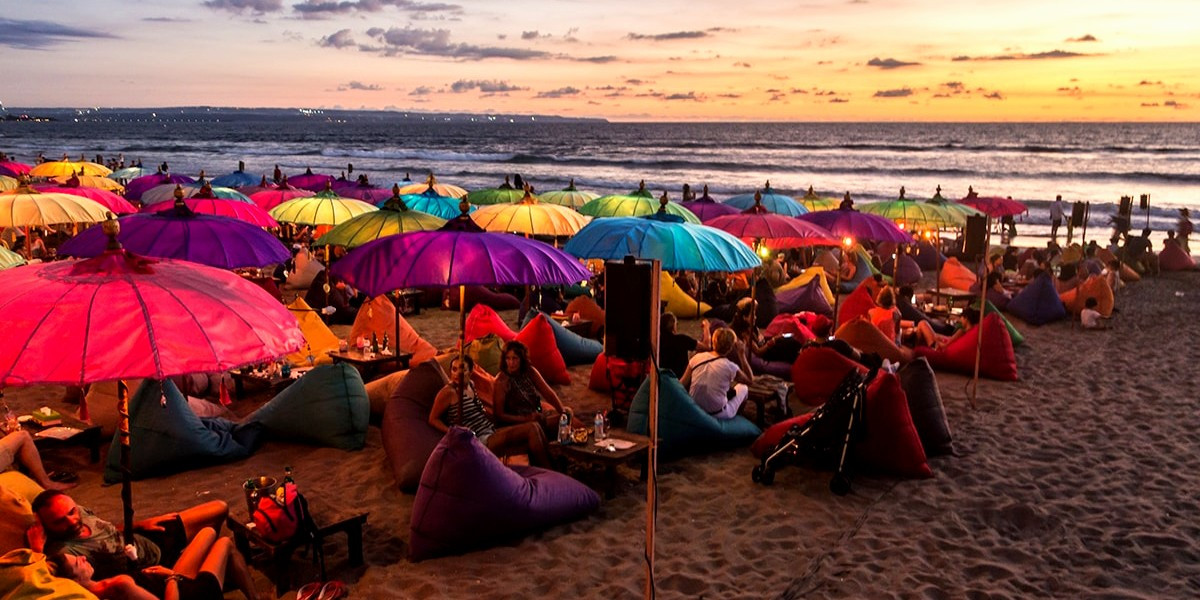Ubud Art and Culture
Ubud, often referred to as the cultural heart of Bali, is a remarkable town where traditional Balinese culture imbues every aspect of life. Renowned for its artistic heritage and serene natural surroundings, Ubud offers a unique and enriching experience for visitors seeking to delve into the island's cultural depths.
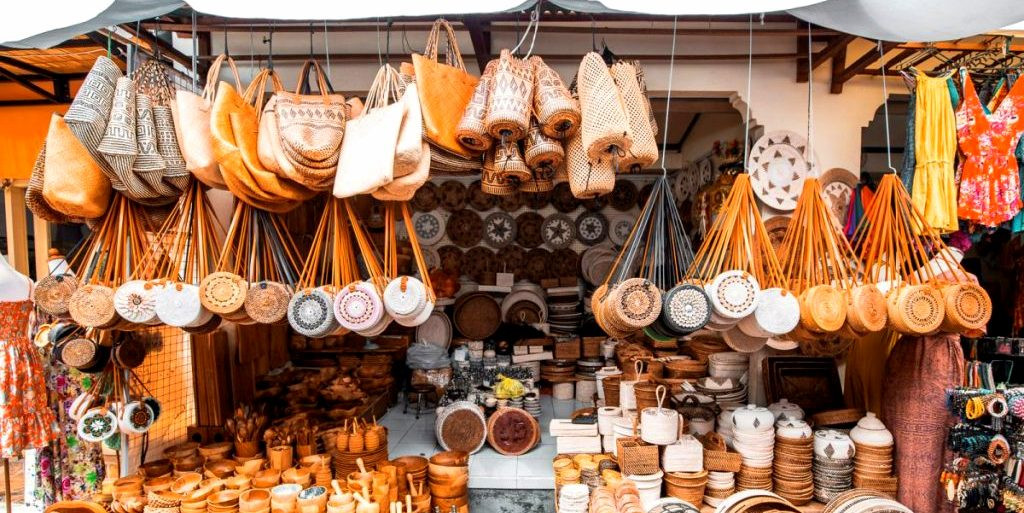
Artistic Legacy and Galleries
-
Ubud has long been a haven for artists, both local and international. This artistic influence is evident in the myriad art galleries scattered throughout the town. These galleries showcase a diverse range of art forms, from traditional Balinese paintings and sculptures to contemporary art.
-
The Agung Rai Museum of Art (ARMA) and the Neka Art Museum are two prominent galleries where you can appreciate the evolution of Balinese art. They house extensive collections of works by Balinese masters and expatriate artists who have influenced Balinese art.
Traditional Dance and Music
-
Ubud is also a vibrant center for Balinese dance and music. Traditional performances like the Kecak dance, Legong dance, and Barong dance are regularly staged in various locations around Ubud, including the Ubud Palace and local temples.
-
These performances are not just entertaining but are deeply rooted in Balinese Hindu traditions and often depict stories from Hindu epics like the Ramayana.
Crafts and the Ubud Art Market
-
The Ubud Art Market, located in the center of Ubud town, is a bustling hub where local artisans and craftsmen sell a wide array of handmade goods. From intricate silver jewelry and hand-woven textiles to carved wooden sculptures and colorful paintings, the market is a testament to the artistic skills of the Balinese people.
-
Shopping in the Ubud Art Market not only provides a chance to find unique souvenirs but also supports the local artisan community.
Spiritual and Holistic Wellness
-
Beyond art, Ubud is known for its holistic wellness scene. The town is dotted with yoga studios and wellness retreats offering a range of programs, from meditation and yoga to holistic healing practices.
-
The serene environment, surrounded by rice fields and lush forests, provides the perfect backdrop for these spiritual and wellness pursuits.
Cultural Workshops and Learning Experiences
-
Visitors to Ubud have the opportunity to engage more deeply with Balinese culture through various workshops. These include traditional Balinese cooking classes, woodcarving, painting, and batik-making workshops.
-
Such interactive experiences offer a hands-on approach to understanding and appreciating the local culture.
Ubud's art and culture scene is an immersive tapestry that weaves together the richness of Balinese traditions, spirituality, and artistic expression. For those looking to experience the soul of Bali, Ubud is an indispensable destination.
Tegallalang Rice Terraces
The Tegallalang Rice Terraces in Bali are one of the island's most iconic landscapes, a testament to Bali's age-old irrigation system known as 'subak.' Located north of Ubud, these terraces offer visitors a glimpse into traditional Balinese rice farming and present an awe-inspiring natural spectacle.
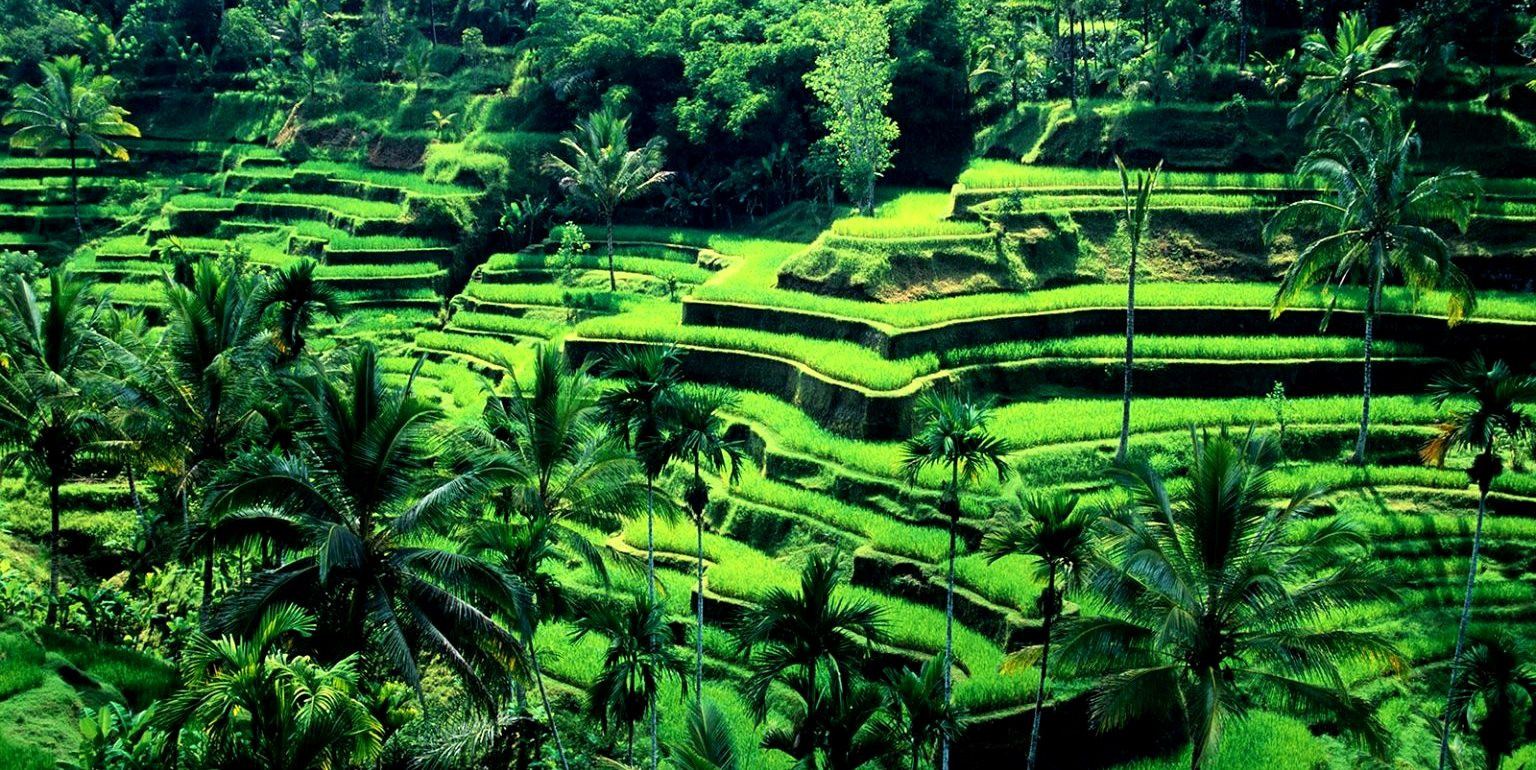
Stunning Natural Beauty
-
The rice terraces are famed for their precise and intricate layout, cascading down the slopes of the Tegallalang valley. The lush green paddies create a vibrant patchwork that changes hues with the seasons, from emerald green in the early stages of growth to golden yellow when the rice is ready to be harvested.
-
This harmonious blend of human ingenuity and natural beauty makes the Tegallalang Rice Terraces a photographer's paradise and a must-visit for nature enthusiasts.
Cultural Significance
-
The terraces embody the Balinese traditional irrigation system called 'subak,' recognized as a UNESCO World Heritage site. This cooperative water management system dates back to the 9th century and reflects the philosophical concept of Tri Hita Karana, which brings together the realms of the spirit, the human world, and nature.
-
Understanding this system offers insight into the communal and sustainable agricultural practices of the Balinese people.
Exploring the Terraces
-
Visitors can explore the rice terraces by walking along the narrow paths that cut through the fields. This not only allows for a closer look at the rice paddies but also offers the chance to meet and interact with local farmers.
-
There are numerous vantage points and cafes perched on the hillside, where one can relax and enjoy the panoramic views of the terraces.
Cultural Activities and Souvenirs
-
Around the Tegallalang Rice Terraces, there are several craft shops and stalls selling traditional Balinese souvenirs. These range from hand-carved wooden sculptures to locally made textiles.
-
The area is also known for its art and crafts, and visitors can stop by workshops or studios to see local artisans at work.
Visiting the Tegallalang Rice Terraces is not just about witnessing a breathtaking landscape; it's an opportunity to appreciate a centuries-old cultural tradition that is integral to Balinese life. This magnificent sight offers a peaceful retreat and a deeper understanding of the island's agricultural heritage.
Mount Batur Sunrise Hike
The Mount Batur Sunrise Hike in Bali is an exhilarating adventure that attracts many visitors seeking a unique experience. Mount Batur, an active volcano located in the Kintamani District in Bali, is renowned for its stunning sunrise views from the summit. The hike is a blend of physical challenge and natural beauty, offering a memorable experience for those who undertake it.
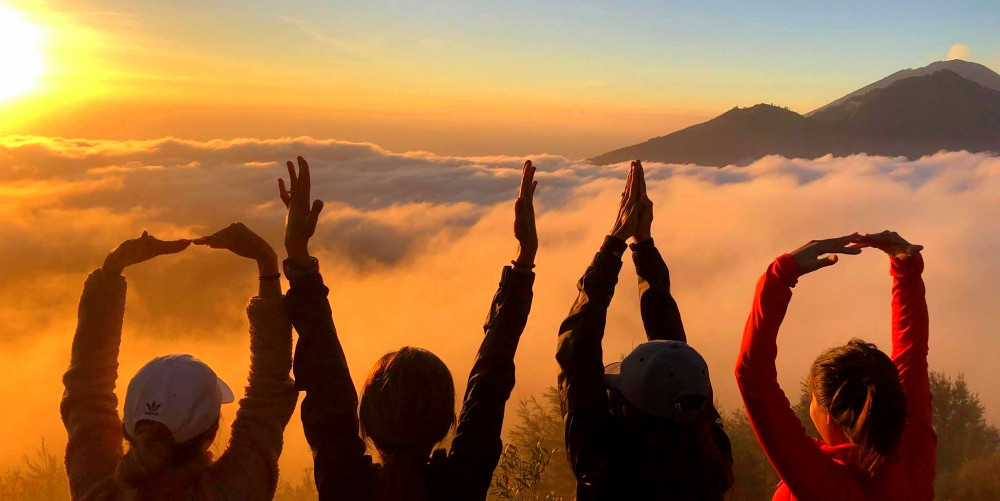
The Hiking Experience
-
The hike typically starts early in the morning, around 2 to 4 AM, depending on your starting point. The goal is to reach the summit (1,717 meters above sea level) in time to witness the sunrise.
-
The trek is considered moderately challenging. It usually takes about 1.5 to 2 hours to reach the top. The path is well-trodden and guides are available to lead the way, making it accessible even for those with moderate fitness levels.
Sunrise at the Summit
-
The reward for the early start and climb is the breathtaking sunrise view from the summit. As the sun creeps above the horizon, it illuminates the sky in vibrant hues, casting a magical glow over the surrounding landscape.
-
On a clear day, the view extends across the Lombok Strait to Mount Rinjani in Lombok, and around to the peaks of Mount Agung and Mount Abang in Bali.
Geothermal Activity
-
Mount Batur is an active volcano, and signs of its geothermal activity are visible at the summit. Steam vents emit vapors, a reminder of the natural forces at play beneath the surface.
-
Some guided tours include the option to cook eggs or bananas in the steaming vents, adding a unique twist to the hiking experience.
Cultural and Spiritual Significance
-
The volcano holds significant spiritual importance for the Balinese people. It is thought to be a replica of Mount Meru, the central axis of the universe in Hindu cosmology.
-
There are several temples around the base and on the slopes of Mount Batur, reflecting its sacred status.
The Mount Batur Sunrise Hike is more than just a trek; it's an opportunity to connect with nature, witness the awe-inspiring beauty of Bali, and experience a spiritual and physical journey. It's a must-do for adventure seekers and nature lovers visiting the island.
Sacred Monkey Forest Sanctuary in Ubud
The Sacred Monkey Forest Sanctuary, located in the heart of Ubud, Bali, is not only a popular tourist attraction but also an important site for Balinese Hinduism and a vital ecological reserve. This unique forest sanctuary is home to a thriving population of long-tailed macaques, who live among ancient temples and dense jungle foliage.
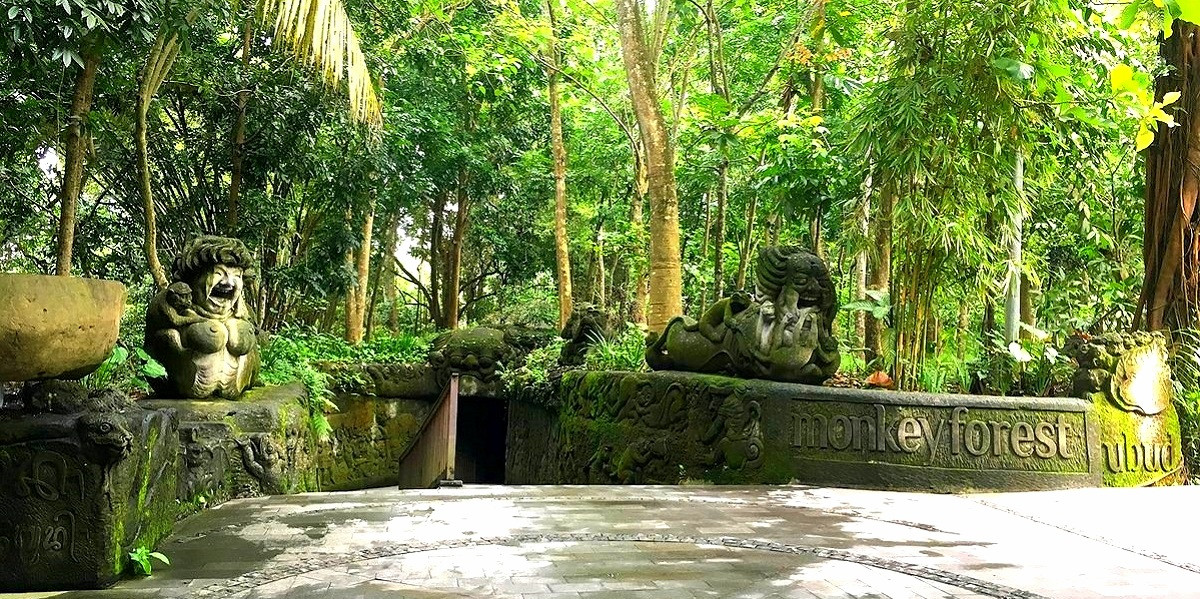
A Haven for Monkeys and Spirituality
- The sanctuary is primarily known for its over 700 grey long-tailed macaques. These monkeys are revered by locals and are considered sacred. They are also quite accustomed to human visitors, although it's important to interact with them respectfully and cautiously.
- The monkeys live freely in this dense rainforest, which spans about 12.5 hectares and provides an important ecological balance in the area.
Ancient Temples Amidst Natural Beauty
- Within the forest, you'll find three Hindu temples, believed to date back to the 14th century. These temples are beautiful examples of Balinese architecture and are used for local religious ceremonies.
- The most prominent among these is the Pura Dalem Agung Padangtegal, or the Great Temple of Death, which plays a significant role in the spiritual life of the local community.
Cultural and Environmental Conservation
- The Monkey Forest is not just a tourist destination but also a center for conservation and research efforts. The sanctuary is managed by the local community, who strive to maintain a harmonious relationship between the sacred site, its wildlife, and visitors.
- Environmentalists and researchers also study the macaques' behavior, contributing valuable insights into primate behavior and conservation.
Visitor Experience
- As you walk through the shaded forest paths, you'll be surrounded by towering banyan trees and other tropical flora, creating a mystical and serene atmosphere.
- While the monkeys are generally friendly, visitors are advised to follow the sanctuary's guidelines to ensure a safe and respectful experience. This includes not feeding the monkeys and keeping belongings secure.
Accessibility and Guidelines
- The Sacred Monkey Forest Sanctuary is easily accessible from anywhere in Ubud. It’s open daily, with a small entrance fee that contributes to the conservation and maintenance of the sanctuary.
- Visitors are advised to wear comfortable walking shoes and bring water, as exploring the forest and temples can take several hours.
Visiting the Sacred Monkey Forest Sanctuary in Ubud is a unique experience that combines natural beauty, cultural richness, and spiritual significance. It's a must-visit for those seeking a deeper understanding of Balinese culture and an up-close encounter with one of the island's most famous inhabitants.
Balinese Cooking Classes
Participating in a Balinese cooking class is an enriching and enjoyable way to immerse yourself in the culinary traditions of Bali. These classes offer a hands-on experience in preparing traditional Balinese dishes, allowing you to delve deeper into the island's rich culture and diverse flavors.
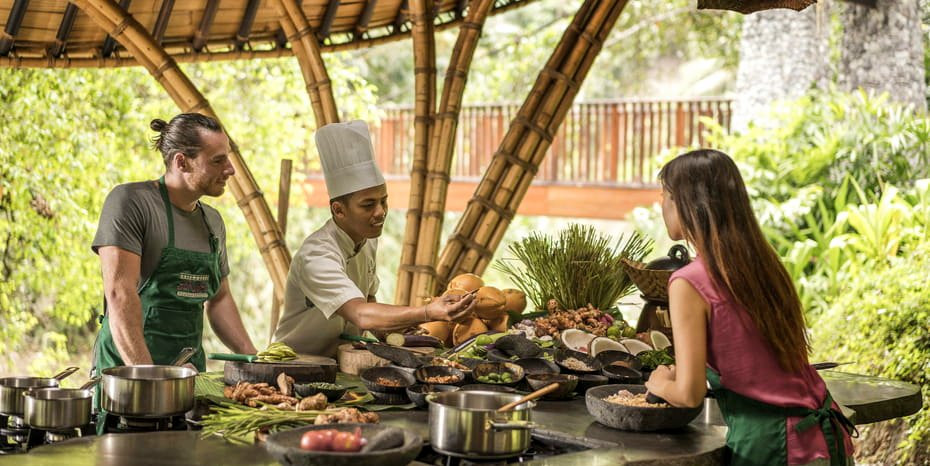
A Culinary Journey Through Balinese Cuisine
- Balinese cuisine is known for its complex flavors and unique blend of spices, with a balance of sweet, sour, spicy, and savory elements. It's heavily influenced by Indonesian, Chinese, and Indian culinary traditions, making it a vibrant and diverse gastronomic experience.
Market Tours and Ingredient Selection
-
Many cooking classes begin with a visit to a local market. This is a crucial part of the experience, as it provides insight into the daily lives of the Balinese and their food practices. You'll learn about local ingredients, herbs, and spices, and how to select the freshest produce.
-
These market visits are not only educational but also a sensory delight, with the vibrant colors and aromas of fresh fruits, vegetables, and spices.
Hands-On Cooking Experience
-
In the cooking class, you will be guided by expert chefs who share their knowledge of Balinese cooking techniques and traditions.
-
Participants typically learn to make a variety of dishes, which may include classic items like Nasi Goreng (Balinese fried rice), Satay (grilled skewered meat), Sambal (spicy chili sauce), and Babi Guling (Balinese roast pork).
Understanding Balinese Food Culture
- The classes often provide more than just cooking skills. They offer insights into the role of food in Balinese ceremonies and daily life, emphasizing the cultural significance of meals and communal eating.
Enjoying the Culinary Creations
- Perhaps the best part of the experience is sitting down to enjoy the meal you've prepared. This communal eating experience is a wonderful opportunity to bond with fellow cooking enthusiasts and savor the authentic flavors of Balinese cuisine.
Suitable for All Skill Levels
- Balinese cooking classes cater to all skill levels, from beginners to experienced cooks, making them a fun and inclusive activity for everyone.
Take Home More Than Just Recipes
- Participants usually leave with a recipe book or handouts, so you can recreate the dishes at home and share your Balinese culinary adventure with friends and family.
A Balinese cooking class is more than just a lesson in cooking; it's an exploration of the island's culture, flavors, and traditions. It's an activity that promises to be as enriching as it is delicious, making it a must-do for any food lover visiting Bali.
Sidemen Valley Activities
Sidemen Valley, nestled in the eastern part of Bali, is a hidden gem that offers a tranquil escape from the island's more touristic areas. Known for its stunning landscapes of lush green rice terraces and traditional Balinese villages, Sidemen Valley is a haven for travelers seeking to experience the serene and authentic side of Bali.
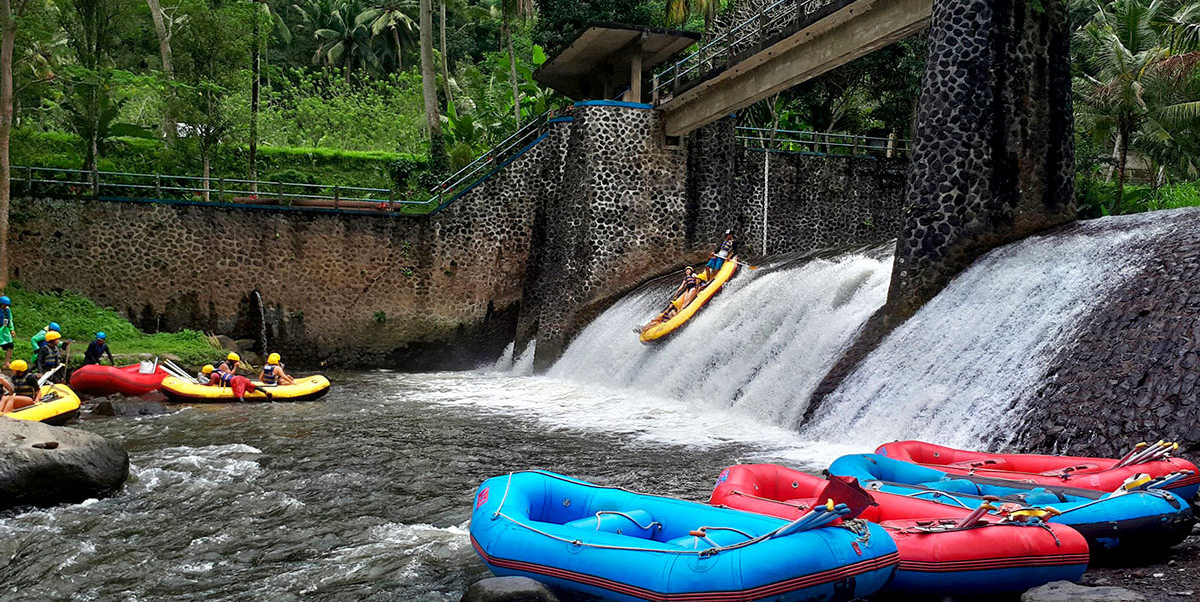
Trekking and Exploring the Natural Beauty
-
The valley's picturesque landscapes make it an ideal location for trekking. Trails range from easy walks through the rice fields to more challenging hikes up the surrounding hills, offering breathtaking views of the countryside.
-
Guided treks can provide insightful information about local flora and fauna, as well as the agricultural practices and rural life of the Balinese people.
Cultural Village Tours
-
Exploring the traditional villages in Sidemen Valley is a must. These tours give you a glimpse into the daily life and customs of the local Balinese community.
-
You can observe artisans at work, creating intricate weavings or crafting ceremonial offerings, and gain a deeper understanding of the local culture and traditions.
Cycling Tours
-
Cycling is another great way to explore Sidemen Valley. Biking through the quiet roads and paths allows you to cover more ground and enjoy the scenic beauty at a leisurely pace.
-
Many tours offer various routes suitable for different fitness levels, ensuring an enjoyable experience for all.
Traditional Cooking Classes
- Participate in a cooking class to learn how to prepare authentic Balinese dishes. These classes often involve a visit to the local market to source fresh ingredients, followed by cooking lessons in a traditional kitchen setting.
Yoga and Wellness Retreats
- The tranquil and natural setting of Sidemen Valley makes it a perfect location for yoga and wellness retreats. Many resorts and retreat centers offer programs that include yoga sessions, meditation, and spa treatments, providing a rejuvenating experience for the body and mind.
Rafting on Telaga Waja River
- For adventure enthusiasts, the Telaga Waja River in Sidemen offers exciting white-water rafting experiences. The river has various rapids that cater to both beginners and experienced rafters, providing a thrilling way to enjoy the valley's natural beauty.
Visiting Ancient Temples
- The valley is also home to several ancient temples worth visiting. These temples, set against the backdrop of rice fields and hills, offer a peaceful and spiritual experience.
Agro-tourism
- Engage in agro-tourism activities, such as visiting coffee plantations and organic farms. You can learn about local farming techniques and the production of crops like coffee, cocoa, and tropical fruits.
Sidemen Valley's array of activities caters to all types of travellers, whether you're seeking adventure, cultural immersion, relaxation, or a bit of everything. This beautiful region remains one of Bali's best-kept secrets, offering a glimpse into a more traditional and serene way of life.
Pura Lempuyang Temple
Pura Lempuyang Temple, one of Bali's most revered and picturesque temples, is a must-visit destination for anyone travelling to the island. Known as the "Gates of Heaven," this temple offers a blend of spiritual significance and breathtaking natural beauty.
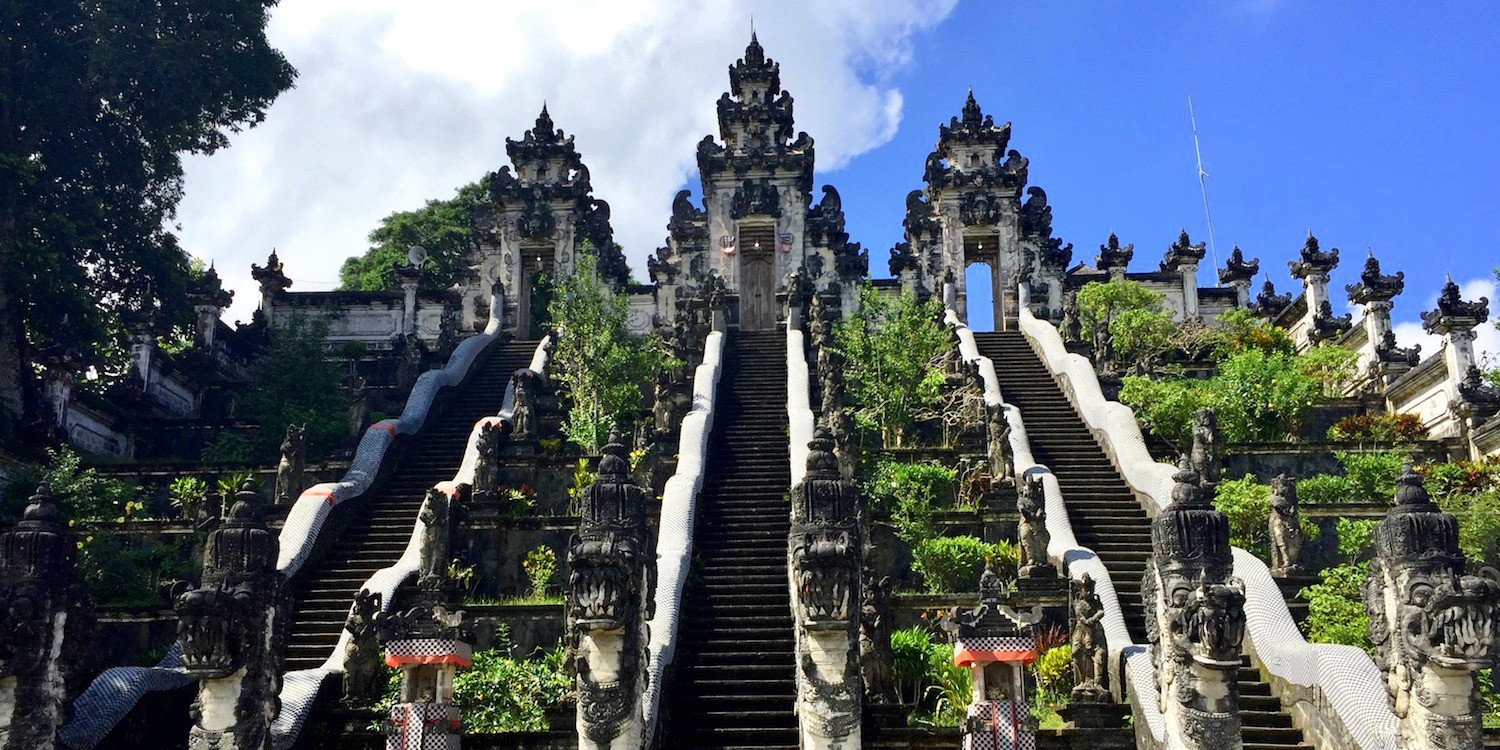
Sacred Site with a Majestic Setting
-
Pura Lempuyang is one of Bali's six most important temples and part of the island's spiritual backbone. Located at the peak of Mount Lempuyang in East Bali, this temple is at an elevation of 1,175 metres above sea level.
-
The journey to the temple is as memorable as the destination itself, involving a steep climb of over 1,700 steps. This ascent is not only a physical challenge but also a spiritual pilgrimage for many.
The Gateway to Heaven
-
The most iconic spot in Pura Lempuyang is its split gateway (Candi Bentar) at the top, framing the majestic Mount Agung in the background. This spot is renowned for its stunning symmetry and panoramic views, making it a favourite for photographers.
-
The "Gateway to Heaven" is often enveloped in mist, creating a mystical and serene atmosphere.
Cultural and Religious Significance
-
Pura Lempuyang is a pivotal part of Balinese Hinduism, and visitors will often see local devotees engaging in prayer and offering rituals. It’s a place that commands respect and reverence.
-
The temple complex consists of several other temples along its ascending path, each offering a unique spiritual experience.
Visitor Guidelines
-
Visitors are required to dress modestly, with sarongs and sashes available for rent at the entrance. It's important to respect the local customs and religious practices while visiting.
-
It is recommended to visit the temple early in the morning to avoid the crowds and to experience the tranquil ambiance fully.
Photography and Etiquette
-
While the temple is a popular spot for photography, it's crucial to maintain a respectful attitude, remembering that this is a place of worship first and foremost.
-
The temple authorities have set up guidelines for taking photos at the Gateway to Heaven to ensure a respectful and orderly experience for all.
Pura Lempuyang Temple is not just a tourist attraction but a profound cultural and spiritual landmark. Visiting this temple offers a chance to witness the beauty of Balinese Hindu architecture and to experience a sense of peace and spirituality that is hard to find elsewhere.
Hidden Waterfalls in Bali
Bali, an island renowned for its stunning beaches, is also home to a plethora of hidden waterfalls, offering serene beauty and a refreshing escape from the more crowded tourist spots. These secluded waterfalls, nestled in the lush Balinese jungle, provide a perfect blend of adventure and tranquilly for nature lovers and explorers.
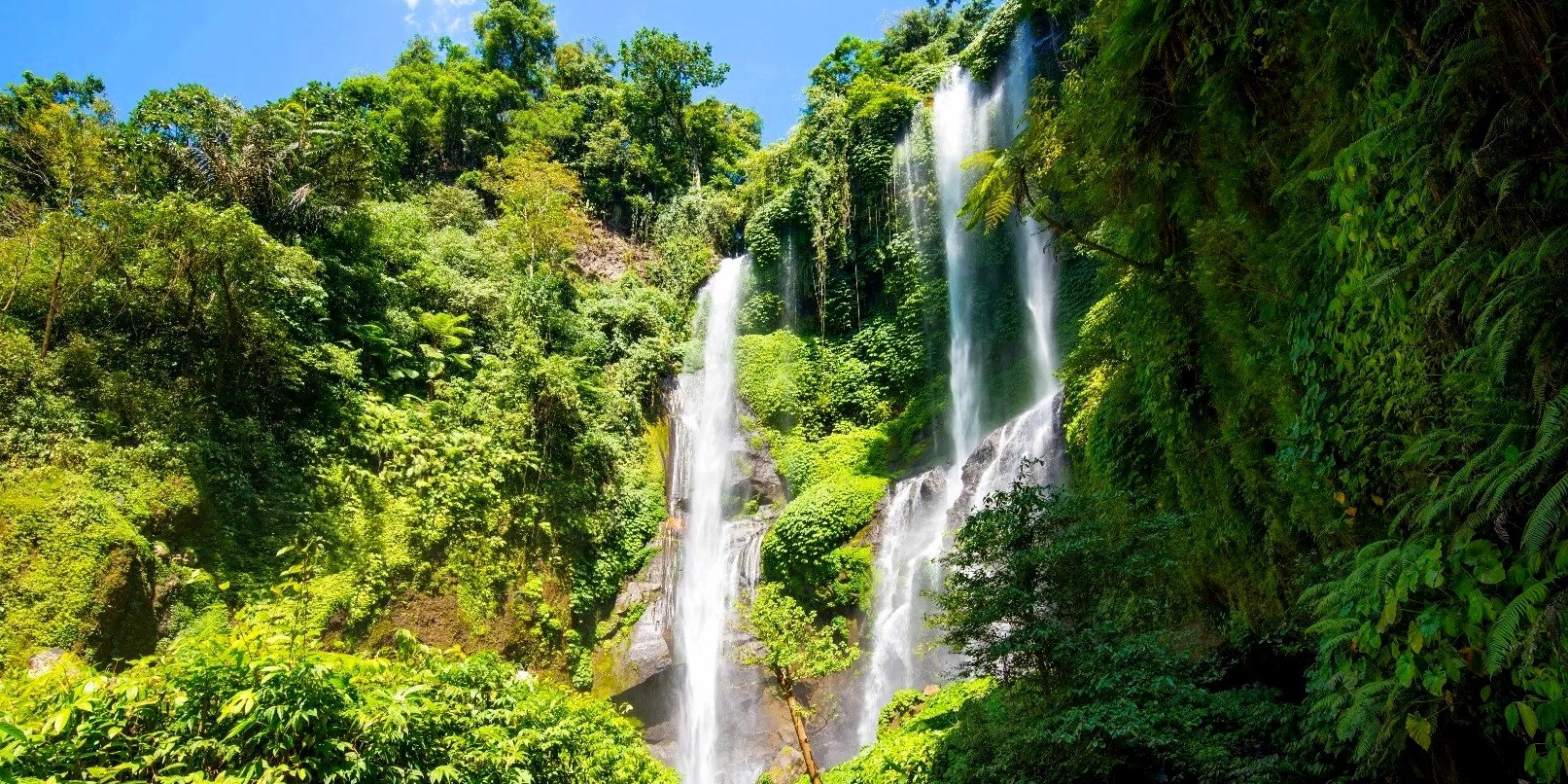
Sekumpul Waterfall
-
Often referred to as the most beautiful waterfall in Bali, Sekumpul Waterfall is located in the northern part of the island.
-
It comprises a series of about seven waterfalls cascading through the dense tropical forest. The journey to Sekumpul involves a rewarding trek through local villages and lush landscapes.
Tegenungan Waterfall
-
Located close to Ubud, Tegenungan Waterfall is one of Bali’s not-so-hidden gems but is less crowded compared to other tourist spots.
-
It's known for its lush green surroundings and heavy, impressive flow, making it a popular spot for swimming and photography.
Gitgit Waterfall
-
Situated in North Bali, Gitgit Waterfall is a stunning 40-meter drop surrounded by tropical rainforest.
-
The path to the waterfall is lined with souvenir shops and is relatively easy to access, making it suitable for all ages.
Nungnung Waterfall
-
Nungnung Waterfall, located about 900 metres above sea level, is one of Bali's most majestic waterfalls, known for its powerful water flow and natural beauty.
-
The waterfall is reached by descending a series of steps, providing a truly immersive jungle experience.
Banyumala Twin Waterfalls
-
Banyumala Twin Waterfalls, in North Bali, offer a serene setting with crystal-clear waters, perfect for swimming.
-
The falls are less frequent, offering a peaceful and undisturbed natural experience.
Aling-Aling Waterfall
- Aling-Aling Waterfall in North Bali is unique for its adventure offerings. Apart from the main waterfall, there are smaller falls where visitors can slide down or cliff jump under the supervision of local guides.
Exploring these hidden waterfalls in Bali not only provides a refreshing break from the beach but also an opportunity to connect with the island's natural beauty. Each waterfall has its own unique charm, making them worthy additions to any Bali itinerary.
Northern Bali Attractions
Northern Bali, known for its serene landscapes and unique attractions, offers a different experience compared to the island's southern part. This region is less crowded and commercialised, providing a more authentic and tranquil Balinese experience. Here are some key attractions in Northern Bali:
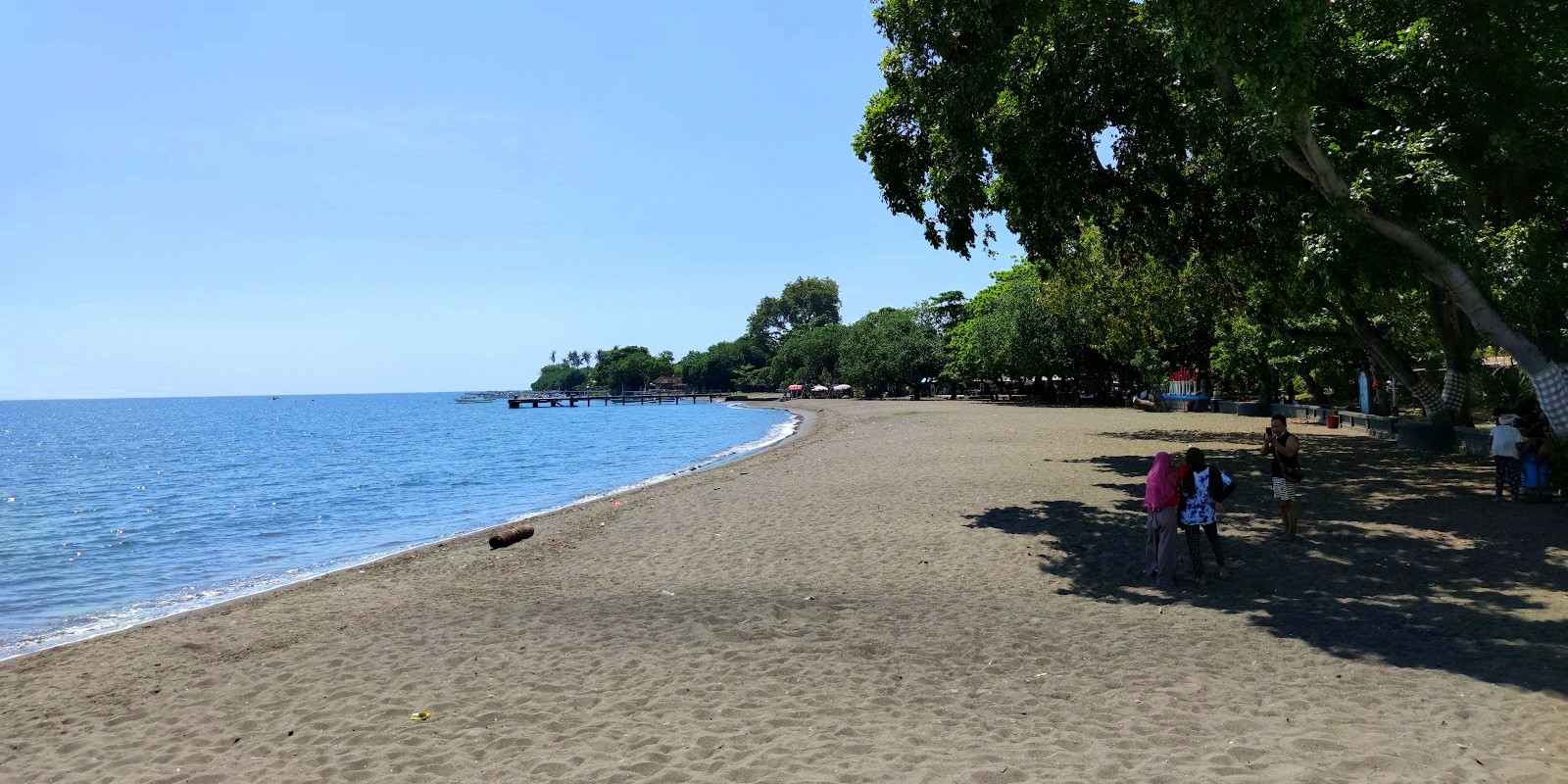
Lovina Beach
-
Famous for its black volcanic sand and calm waters, Lovina Beach is a stark contrast to the white sandy beaches of south Bali. It's particularly famous for dolphin-watching tours, where visitors can take a boat out at sunrise to see dolphins in their natural habitat.
-
Lovina also offers a relaxed beachside atmosphere, with various restaurants and cafes along the shore.
Banjar Hot Springs
-
The Banjar Hot Springs, locally known as 'Air Panas Banjar,' are a set of naturally formed hot springs, surrounded by lush jungle. The sulfuric water, believed to have healing properties, flows into several pools and public baths, providing a soothing and therapeutic experience.
-
The hot springs also feature traditional stone carvings and a picturesque setting, making it a culturally rich and relaxing experience.
Brahma Vihara Arama Buddhist Monastery
-
This is Bali’s largest Buddhist monastery, often referred to as Bali's mini Borobudur, due to its similar architectural style. It offers a serene atmosphere with beautifully landscaped gardens, meditation rooms, and intricate Balinese decoration.
-
The monastery provides an insight into the spiritual diversity of Bali and is an ideal place for meditation and reflection.
Gitgit Waterfall
-
Located between Bedugul and Singaraja, Gitgit Waterfall is one of the most visited waterfalls in north Bali. It offers an easily accessible and picturesque natural attraction, surrounded by lush tropical forest.
-
The waterfall cascades down from a height of about 35 meters into a rocky pool, making it a perfect spot for nature lovers and photographers.
Munduk Village
-
Munduk village, with its cool mountain air and panoramic views, is a haven for trekkers and nature enthusiasts. The area is known for its beautiful waterfalls, coffee and clove plantations, and scenic trekking routes.
-
The village offers a peaceful retreat in the mountains, with traditional Balinese homes and homestays for an authentic experience.
Menjangan Island
-
Part of the West Bali National Park, Menjangan Island is known for its beautiful coral reefs and diverse marine life, making it a popular spot for snorkeling and diving.
-
The island is uninhabited and can be reached by a short boat ride, offering pristine beaches and a tranquil environment.
Temples and Cultural Sites
- North Bali is dotted with several significant temples, including Pura Ulun Danu Bratan, a picturesque temple on the shores of Lake Bratan, and Pura Ponjok Batu, a temple by the sea with unique rock formations.
Exploring the attractions of Northern Bali provides a more serene and culturally immersive experience. The region's natural beauty, combined with its cultural richness, makes it a compelling destination for those looking to explore beyond Bali's well-trodden paths.
Unique Experiences in Bali
Bali, often known for its stunning beaches and vibrant nightlife, also offers a wealth of unique experiences that delve deep into its cultural and natural wonders. These experiences provide an opportunity to see a different side of Bali, away from the usual tourist trails.
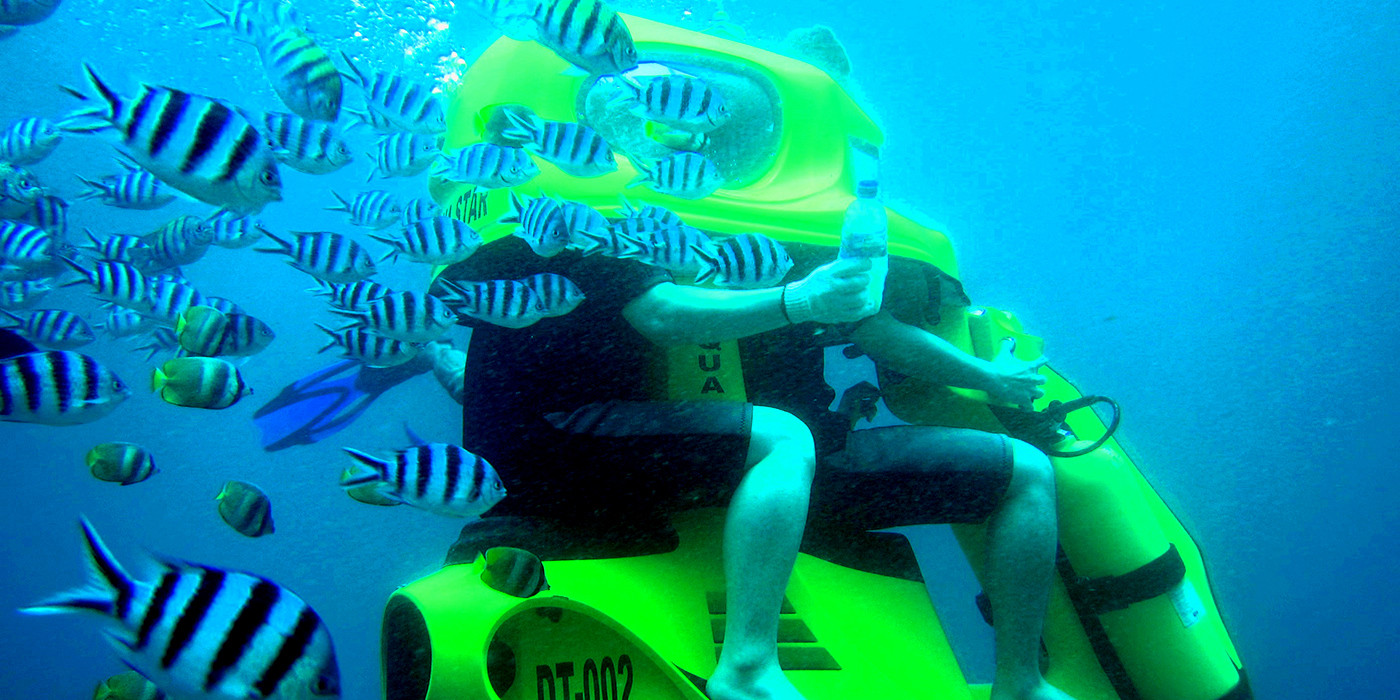
-
Traditional Balinese Healer Visit: Experience the ancient practice of Balinese healing. Visit a traditional Balinese healer, also known as a "Balian," to understand the holistic and spiritual approach to health in Balinese culture. These healers use a combination of massage, herbal medicine, and spiritual guidance.
-
Nighttime Volcano Trekking: For a twist on the popular daytime treks, embark on a nighttime hike to one of Bali’s volcanoes, such as Mount Batur. Witnessing the sunrise from the summit is even more magical when you ascend under the stars.
-
Balinese Mask Making Workshop: Engage in a mask-making workshop in a local village. Balinese masks are an integral part of the island's cultural heritage and are used in various ceremonies and dances. Learning this craft offers a hands-on approach to understanding Balinese art and culture.
-
Sunset at Tanah Lot Temple: While Tanah Lot is a well-known temple, watching the sunset here remains a unique experience. The temple is perched on a rock formation off the coast, creating a stunning silhouette against the setting sun.
-
Silent Retreats: Embrace tranquilly and mindfulness at one of Bali’s silent retreats. These retreats, set in serene locations, offer a chance to disconnect from the external world and reconnect with your inner self through meditation, yoga, and nature.
-
Balinese Cooking Class in a Local Village: Go beyond the usual cooking classes by joining one in a traditional village. Learn how to cook Balinese dishes using age-old techniques and locally sourced ingredients, often in an open-air kitchen surrounded by nature.
-
Underwater Scooter Riding: Explore Bali's underwater world in a unique way with an underwater scooter. This activity allows you to ride a scooter on the ocean floor, surrounded by tropical fish and coral reefs, offering a memorable underwater adventure.
-
Cultural Immersion in Penglipuran Village: Visit Penglipuran, a traditional village known for its well-preserved architecture and community-based lifestyle. Walking through this village feels like stepping back in time, offering insights into the traditional Balinese way of life.
-
Sunrise Dolphin Watching in Lovina: Take a boat out into the calm waters of Lovina Beach at dawn to witness pods of dolphins swimming and jumping in their natural habitat. This peaceful experience is a gentle reminder of Bali's diverse marine life.
-
Secret Canyon Exploration: For the adventurous, explore the hidden canyons of Bali, such as the Beji Guwang Hidden Canyon. These natural formations offer a thrilling experience of trekking through narrow gorges and natural pools.
Each of these unique experiences in Bali allows travellers to create deeper connections with the island’s culture, nature, and spirituality, making their visit truly unforgettable.
Tips for Bali Beyond Beaches: Exploring the Island's Hidden Gems
Exploring Bali beyond its renowned beaches can lead to a myriad of unforgettable experiences. To make the most of your journey into the island's hidden gems, here are some essential tips:
Plan Your Itinerary Wisely
- Research and plan ahead. Bali is rich in culture and natural beauty, so prioritise the places you most want to see. Consider travel time between different locations, especially if they are in remote areas.
Respect Local Customs and Traditions
-
Bali has a unique culture deeply rooted in Hinduism. Always show respect at temples and sacred sites by dressing appropriately and following local customs.
-
When visiting traditional villages or participating in cultural activities, be mindful of and respectful of the local way of life.
Hire a Local Guide for Off-the-Beaten-Path Explorations
- For hidden gems like secluded waterfalls or traditional villages, consider hiring a local guide. They can provide valuable insights, help communicate with locals, and enrich your experience.
Pack Appropriately for Various Activities
- Depending on your activities, pack accordingly. This includes comfortable walking shoes for hiking, light clothing for the humid climate, and appropriate attire for temple visits (like sarongs).
Try Local Cuisine
- Venture beyond international restaurants and try local warungs (small eateries) to experience authentic Balinese cuisine. Cooking classes can also be a great way to learn about the local food culture.
Embrace Sustainable Tourism Practices
-
Support local businesses and eco-friendly initiatives to help preserve Bali’s natural and cultural heritage.
-
Be environmentally conscious, especially in sensitive areas like coral reefs or rice terraces. Avoid single-use plastics and respect wildlife habitats.
Stay Hydrated and Protected from the Sun
- Bali’s tropical climate can be dehydrating. Always carry water with you and use sun protection, especially when engaging in outdoor activities.
Be Prepared for the Road
-
If you plan on renting a scooter, ensure you're comfortable with the local driving conditions and have the necessary license and insurance.
-
Alternatively, hiring a driver can be an efficient and stress-free way to explore, especially for longer distances.
Learn Basic Balinese or Indonesian Phrases
- Knowing simple phrases in Balinese or Indonesian is not only courteous but can also enhance your interactions with locals.
Stay Flexible and Open to New Experiences
- While planning is important, sometimes the best experiences are unplanned. Be open to local recommendations and spontaneous adventures.
Exploring Bali's hidden gems offers a more holistic view of the island, revealing its cultural depth and natural beauty. With these tips, your journey through Bali's less-traveled paths promises to be as enriching as it is exciting.
Visa for Bali Beyond Beaches: Exploring the Island's Hidden Gems
When planning a trip to Bali, especially for an extended exploration beyond the beaches, it's important to understand the visa requirements. As of my last update in April 2023, here’s what you should know about obtaining a visa for Bali, Indonesia:
Visa Exemption
- Many countries are eligible for a visa exemption when visiting Bali for short stays (usually up to 30 days). This exemption is generally for tourism purposes and does not allow for extension or conversion to another visa type. Check if your country is on this list before planning your trip.
Visa on Arrival (VoA)
-
For those not eligible for the visa exemption, or if you want the option to extend your stay, Indonesia offers a Visa on Arrival (VoA) for tourists. This visa typically allows for a 30-day stay and can often be extended for another 30 days while in Indonesia.
-
The VoA is available at designated entry points, including Bali’s Ngurah Rai International Airport. There is a fee associated with the VoA.
Social, Tourist, or Cultural Visa
-
If you plan to stay longer than 60 days or your purpose of visit includes social, family, or cultural reasons, you might consider applying for a Social, Tourist, or cultural visa. This type of visa often requires sponsorship from an Indonesian citizen or a letter from an Indonesian organization.
-
This visa typically allows for a longer stay but might require more documentation and preparation.
Multiple Entry Visa
- For those who plan to enter and exit Indonesia multiple times over a longer period, a Multiple Entry Visa might be appropriate. This visa is valid for several months to a year, but each stay should not exceed 60 days.
Check the Latest Regulations
- Visa regulations can change, so it’s crucial to check the latest information from the Indonesian embassy or consulate in your country or visit their official immigration website for the most up-to-date requirements.
Prepare Necessary Documentation
-
Ensure your passport is valid for at least 6 months from the date of arrival in Bali.
-
Have proof of onward or return travel, and sometimes proof of sufficient funds for your stay may be required.
Consider Health and Travel Insurance
- While not always a visa requirement, having health and travel insurance is highly recommended, especially considering the ongoing global health scenarios.
Covid-19 Considerations
- Given the ever-changing nature of travel during the COVID-19 pandemic, be sure to check for any additional health-related entry requirements, such as vaccination certificates, testing, or quarantine measures.
By understanding and preparing for the visa requirements, your exploration of Bali’s hidden gems can be a smooth and enjoyable experience. Remember, the type of visa you need will depend on your nationality, the purpose of your visit, and the length of your stay.
Health and Safety for Bali Beyond Beaches: Exploring the Island's Hidden Gems
When venturing beyond the beaches to explore Bali's hidden gems, it's crucial to consider health and safety precautions. Here are some essential tips to ensure a safe and healthy trip:
Vaccinations and Health Precautions
-
Before travelling, check if any vaccinations are recommended or required for Bali. Commonly recommended vaccines include Hepatitis A and B, Typhoid, and Tetanus.
-
Consider a consultation with a travel medicine specialist, especially if you plan to visit remote areas.
Travel Insurance
- Obtain comprehensive travel insurance that covers medical emergencies, accidents, and evacuations. Ensure that it includes coverage for activities you plan to engage in, such as hiking or water sports.
Protect Against Mosquito-Borne Diseases
-
Use mosquito repellent, especially in rural and jungle areas, to protect against diseases like dengue fever and the Zika virus.
-
Wearing long sleeves and pants during dawn and dusk and sleeping under a mosquito net (if staying in open-air accommodations) can provide additional protection.
Food and Water Safety
-
Drink bottled or purified water. Avoid tap water, including ice in drinks.
-
Eat well-cooked food and be cautious with street food. Choose busy stalls with a high turnover of fresh produce.
Sun Protection
-
The Balinese sun can be intense. Use a broad-spectrum sunscreen with high SPF, wear hats, and use sunglasses with UV protection.
-
Stay hydrated, especially when spending extended periods outdoors.
Road Safety
-
If you plan to rent a scooter, wear a helmet and be aware of Bali's traffic and road conditions, which can be chaotic and challenging for inexperienced riders.
-
Consider hiring a driver for longer distances or in unfamiliar areas for safer and more relaxed travel.
Be Cautious in Natural Settings
-
When hiking or exploring waterfalls and jungles, be aware of your surroundings. Stay on marked trails, be cautious near cliff edges, and avoid swimming in unfamiliar waters.
-
Be aware of local wildlife, and do not provoke or feed wild animals.
Respect the Ocean
-
Heed warnings about strong currents and riptides, especially on less familiar beaches.
-
Be mindful of marine life while snorkelling or diving. Never touch coral reefs or disturb sea creatures.
Emergency Preparedness
-
Know the location of the nearest medical facilities in the areas you will be visiting.
-
Keep emergency contacts handy, including those of local emergency services and your country’s embassy or consulate.
Respect Local Culture and Customs
By taking these precautions, you can enjoy the diverse and enriching experiences that Bali offers beyond its beaches, while staying healthy and safe.
Best Time to Visit Bali Beyond Beaches: Exploring the Island's Hidden Gems
Choosing the best time to visit Bali, especially when planning to explore beyond the beaches, largely depends on the weather, tourist seasons, and cultural events. Bali generally has two main seasons: the dry season and the rainy season.
Dry Season (April to October)
-
The dry season, running from April to October, is considered the best time to visit Bali for most activities.
-
This period offers sunny days and low humidity, making it ideal for outdoor activities like hiking, cycling, and exploring the island's hidden gems like rice terraces, volcanoes, and waterfalls.
-
The dry season is also the peak tourist season, particularly from July to August. During these months, popular areas can be crowded, but the more off-the-beaten-path destinations remain relatively tranquil.
Cooler Months (May, June, and September)
- For those who prefer cooler temperatures and fewer crowds, the months of May, June, and September are ideal. These months offer a comfortable climate, and tourist areas are less crowded compared to the peak season.
Rainy Season (November to March)
-
The rainy season spans from November to March. While this season sees more rain and higher humidity, it also brings lush greenery, making the landscapes particularly vibrant.
-
Rainfall usually occurs in the late afternoon or evening and can sometimes be quite heavy, but it's often short-lived, allowing for periods of clear weather.
-
The rainy season is a good time to explore cultural and artistic attractions like temples, museums, and art galleries. It's also the low tourist season, meaning fewer crowds and potentially lower prices for accommodations.
Cultural Events and Festivals
- Bali's cultural calendar is filled with festivals and ceremonies all year round. Notable events include Galungan and Kuningan, Nyepi (Balinese New Year), and the Bali Arts Festival. These events can offer a deep insight into Balinese culture and traditions.
Considerations for Specific Activities
-
For diving and snorkelling, the best visibility is during the dry season, particularly around July and August.
-
Surfing conditions vary depending on the beach and time of year, with the west coast beaches being better during the dry season and the east coast beaches during the rainy season.
while the dry season is generally the best time to explore Bali's outdoor attractions and hidden gems, the rainy season also has its charms, with lush landscapes and a more relaxed pace. Regardless of when you visit, Bali's rich culture and diverse attractions can be enjoyed year-round.
Bali is a treasure trove of hidden gems waiting to be explored. From the cultural richness of Ubud and the majestic beauty of the Tegallalang Rice Terraces to the spiritual serenity of Pura Lempuyang Temple and the exhilarating Mount Batur sunrise hike, Bali offers a diverse array of experiences. Its hidden waterfalls, serene northern landscapes, and unique cultural activities like cooking classes and village tours provide an authentic insight into the island's varied essence. Exploring these aspects of Bali not only enriches your travel experience but also connects you deeply with the island's vibrant soul. Embrace this journey beyond the beaches and let Bali reveal its myriad wonders, leaving you with lasting memories and a deep sense of awe.
FAQs for Bali Beyond Beaches: Exploring the Island's Hidden Gems
Q. What are the must-visit hidden gems in Bali beyond the beaches?
A. Must-visits include the Tegallalang Rice Terraces, the cultural town of Ubud, Mount Batur for sunrise hikes, the Sacred Monkey Forest Sanctuary, and the traditional Balinese villages. Also, explore the Pura Lempuyang Temple and hidden waterfalls like Sekumpul and Gitgit.
Q. Is Bali suitable for adventure seekers?
A. Absolutely! Bali offers numerous adventures like hiking Mount Batur, exploring hidden waterfalls, diving in the Nusa Islands, and cycling through the Sidemen Valley.
Q. What cultural experiences should I not miss in Bali?
A. Don't miss experiencing traditional Balinese dance performances in Ubud, visiting ancient temples, participating in a Balinese cooking class, and exploring local art and craft markets.
Q. How can I experience Bali's nature and wildlife?
A. You can explore the lush landscapes of Bali through trekking, visiting the Sacred Monkey Forest Sanctuary in Ubud, enjoying the serene beauty of Northern Bali, and engaging in wildlife tours.
Q. Are there any unique food experiences in Bali?
A. Yes, Bali offers unique food experiences like street food tours, traditional cooking classes, and dining in local warungs where you can savor authentic Balinese cuisine.
Q. What is the best time to explore Bali beyond its beaches?
A. The best time is during the dry season from April to October, when the weather is more suitable for outdoor activities and cultural exploration.
Q. Do I need a guide to explore Bali's hidden gems?
A. While not always necessary, a local guide can enhance your experience, especially in more remote areas or for activities like trekking and cultural tours.
Q. Is Bali safe for solo travelers?
A. Bali is generally safe for solo travelers, but it's always advisable to follow standard safety precautions, stay informed, and respect local customs and laws.
Q. What should I pack for exploring Bali's inland attractions?
A. Pack comfortable clothing suitable for warm weather, sturdy footwear for trekking, a hat and sunscreen for sun protection, and a reusable water bottle.
Q. How can I respect local culture while exploring Bali?
A. Respect local customs by dressing modestly, especially when visiting temples, and by being mindful and polite in your interactions with the locals.
For the Nepal tour, please click here.
If you are looking for different kinds of Nepal Tours or Trekking Packages, feel free to contact us
